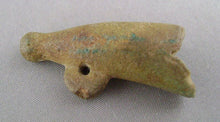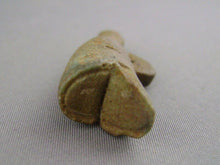Ancient Egyptian Faience Hedjet Crown Amulet, New Kingdom Ex. Gustave Jéquier
Regular price
$995.00
Sale
Here you find a rate ancient Egyptian Faience amulet of the Crown of Upper Egypt. This example is in perfect condition as shown. In a dark green faience, dates to the New Kingdom. Measures 1.4 inches in length. This is a rare amulet, in great condition and nice size!.
Similar amulet is found in the Museum of Fine Arts, Boston.
For reference see: Genesis of the Pharaohs: Genesis of the ‘Ka’ and Crowns? by Timothy Kendall, American Archaeologist.
Ancient Egyptian was born of "two separate lands, north and south, which became a unified whole at the beginning of the dynastic period". Important in showing the pharaoh’s role in unification were the crowns that he wore on his head. As this piece, was the tall and conical white crown, (symbolic of Upper Egypt). On the other hand, flat red crown (symbolized Lower Egypt). The king was shown with either the double crown, which is the red crown surmounted by the white crown. This beautiful faience amulet represents the white crown of upper Egypt; protected by the vulture goddess Nekhbet and the god Set. It was the king of Upper Egypt who emerged victorious from the battle between north and south and perhaps this amulet commemorates that ancient victory!
Provenance: Collected by Gustave Jéquier (1868-1946)
Ex. Billy Jamieson Collection, 2009 (1954-2011)
Authentication: Gayle Gibson, Royal Ontario Museum Toronto
Galleria Delvecchio .… “is pleased to present a collection of Egyptian antiquities assembled by the celebrated Swiss Egyptologist Gustave Jéquier. Jéquier was born in 1868 in Neuchatel. He first studied in Paris under Gaston Maspero (1846-1916) and later went to Berlin before joining the de Morgan expedition to Persia, during which time he contributed to the discovery and decipherment of the code of Hammurabi. Gustave Jéquier was a giant in the field of Egyptology whose contributions are far too numerous to list here. He is best known for his association with the French Institute in Cairo which enabled him to engage in seminal research at the pyramid site of the Old Kingdom. He also completed the work begun at Abydos by his Swiss compatriot, [Henri] Eduard Naville (1844-1926). The two are considered to be Switzerland’s most preeminent Egyptologists. One of Jéquier’s most important discoveries was the 13th Dynasty pyramid of Khendjer. He wrote extensively on his history of Egyptian architecture, and published on philology and religion as well. Gustave Jéquier died in 1946 in the city in which he was born, and most of his collection was acquired by the University of Basel. The works of art presented here were given to a sibling who emigrated to the US in the late 1940’s; the collection later passed to their daughter, Jéquier’s niece.”



